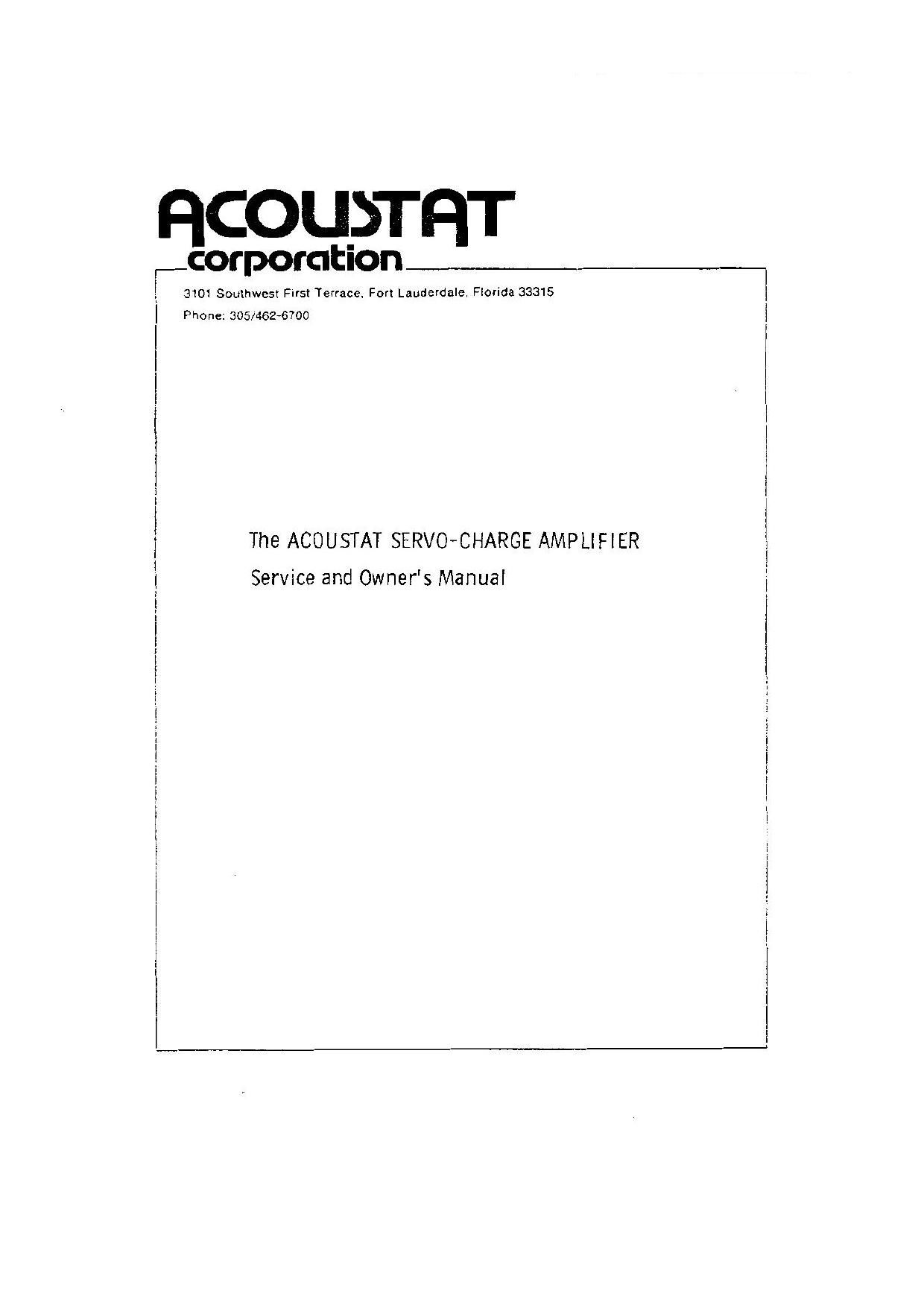Acoustat Monitor 3 Owners Manual
This is the 28 pages manual for Acoustat Monitor 3 Owners Manual.
Read or download the pdf for free.
If you want to contribute, please mail your pdfs to info@audioservicemanuals.com.

Extracted text from Acoustat Monitor 3 Owners Manual (Ocr-read)
Page 1
_corporal:ion
HCOU>THT
3101 Southwest Furs! Tetrace. Fon Lauderdale, Florida 33315
Phone: 305/462~6700
The ACOUSTAT SERVO-CHARGE AMPLIFIER
Service and Owner's Manual
Page 2
ACOUSTAT
SERVO-CHARGE AMPLIFIER
SERVICE MANUAL
Con fen rs:
lntroducfion
Sysrem Sef-Up lnstrucfions
Shielding and Grounding of Audio Systems
Descriprion of the Servo-Charge Amplifier
Block Diagram
Theory of Operation
Constant Charge Electrostufic Panels
lnpu? and Equalization Amplifier
Phase inverter
Recrifier Amplifier
Trigger Amplifier
Panel Bias
Output Amplifier
Power Supplies
Infernal Grounding
Drawings
Overall Schematic
Chassis Assembly
lnpuf Area Assembly
Primed Circuit Assembly
Parts Lisl-
Componenr Changes
Troubleshoofing
Page 4
SET-UP INSTRUCTIONS FOR
ACOUSTAT ELECTROSTATIC
SPEAKER SYSTEMS
The set-up procedure, exclusive of assembly, is the same for all Acoustat
electrostatic speaker systems. We have been able to make the Monitor series
speaker systems more tolerant than the Acoustat X systems for small aberotions
in the set-up and room tuning; but we still advise that the preferred procedure
should be followed fully to obtain the best possible performance from the
system .
Some of the principal considerations which will determine the performance
potential of the speaker system as installed are:
The Wall Behind the Speakers:
This wall should be hard, reflective, and sufficiently rigid that
it will not rattle-~sliding glass doors are a No-No".
The Orientation of the Speaker System Within the Room:
Unless there is an overriding consideration to the contrary, the
speakers should proiect sound along the longer axis of the room.
This can be considered a universal rule of stereo speaker systems
and is in no way peculiar to Acoustat products.
The Grounding of the System:
It is essential that the power supply ground be connected to prevent
any buildup of charges in the Servo-Charge amplifier power supplies.
THE THIRD WIRE GROUND MUST BE CONNECTED.
While the system may function reasonably well with only the
power supply ground, this leaves the main signal ground floating.
THERE MUST BE ONLY ONE SIGNAL GROUND IN THE SYSTEM
and this should normally be provided at the inr v of the preamplifier.
Electric Feedback:
Electrostatic loudspeakers produce a strong electric field which can
influence the operation of any low level electronic circuitry in
close proximity and can result in feedback at frequencies well above
the audio spectrum--this has the effect of high power dissapation and
decreased headroom in the systen The tone arm of the turntable
and the input of the preamplifier should be kept at least six to eigh
feet from the nearest speaker to ensure that no feedback can occur.
Phasing:
Acoustat speaker systems are designed to preserve correct absolute
phase throughout the system including the final coupling of the
signa' to the air. This ensures that vocalists and instruments will
sound as natural as possible. Therefore, make sure that the
connections from the speakers to the amplifiers are correctly oriented:
the wires should enter the three prong Pomono plug from above.
Page 9
THEORY OF OPERATION
in order to understand the operation of the Servo-Charge amplifier, it is very
usefull to have at least a rudimentary understanding of the load which it was
designed to drive,
Acoustat uses what are referred to as constant charge electrostatic transducer
panels in which the electrostatic "plates" are driven in a push-pull format and
the driven diaphram is biased in such a manner that its electrostatic charge
remains constant despite the application of high voltage audio signals to the
electrostatic plates .
l C =q/V
I 1 J =CV2/2
e E is _
s l l1 l w ' F =_Eq
I l
o _
l I Where: C capacitance in fared:
* . + 41 ' V voltage in volt:
l + l ' J energy in ioules
. * V F Force in newton;
4 l ' l _ E electric field in
I | newton: per coulomb '
I * " q charge in coulomb:
I t
i
measure at e lectvic
field
newtons per coulomb
and volts per meter
[ are alternate units at
l
I
While we admit that the physics is not "obvious at a glance" we will, for the
purposes of this amplifier service manual, simply state the electrical requirements
to drive the electrostatic loudspeaker panels that we use at Acoustat Corporation
and not dwell on the physics of electrostatic loudspeaker design.